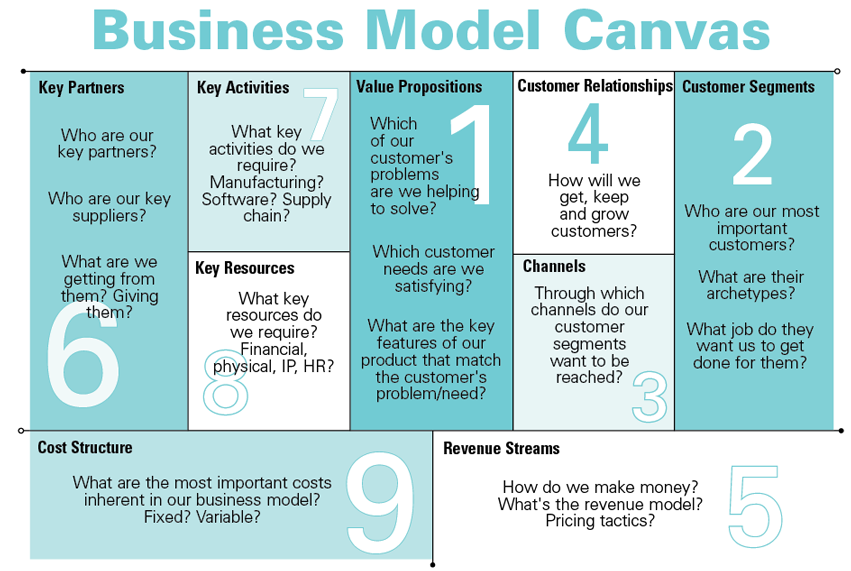On September 27th, 10 teams will start their journey. . .
According to the Small Business Administration, 33 percent of small businesses fail in the first two years, and more than half fail within five years. Numerous studies identify many reasons for these failures, and there is speculation that lack of capital and not having the right team are the biggest contributors to startup failure. However, the research actually points to startups not fully developing a business model as a major cause.
Starting Points for Success
Two organizations that have done quite a bit of research in this area are Frac.tl and CB Insights. Both organizations conclude that the primary reasons startups fail are due to offering a product or service that doesn’t have a market need, and a lack of a viable and scalable business model. Business models, customer traction, identifying product-market fit and customer development are all issues addressed through business-model generation and customer validation. In other words, develop customers and a business model that can scale, and raising investment capital will not be nearly as challenging.
This research may cause you to wonder: how can a company develop successfully? The answer is to start with the problem and validate it, identify the customer pain, develop a solution that solves the pain, validate the solution with the target customer, and build a scalable business model to deliver that solution.
The perfect starting tools are the business model canvas and the value proposition canvas. These tools are the basis for identifying your best guesses about what is important in the decision-making process for your target customers. From these educated guesses, customer validation can be performed to prove or disprove your hypotheses. Actually talking to the target customer face-to-face will give a business the opportunity to understand what is important. Customer validation is the step that most startups skip. It is much easier to create a solution, put that solution into the market and wait for the money to roll in. The difficulty is that, most of the time, the target customers will not identify with the problem or with the solution. That is why taking the time to talk with target customers before launching the business is essential in helping guide the company to developing a solution that best fits the customer’s needs.

Validate, Pivot or Fail Quickly
Identifying the appropriate business model is a challenge, and it is the reason business accelerators have gained popularity. Business accelerators are programs designed to help companies quickly validate their business model, and pivot or fail quickly. This fall, the Illinois Small Business Development Center (SBDC) in the Turner Center for Entrepreneurship at Bradley University is launching the region’s first-of-its-kind business accelerator, Brave Launch.
Brave Launch is modeled after the National Science Foundation’s I-Corps accelerator program and Steve Blank’s Lean LaunchPad. The foundation of the program is evidence-based entrepreneurship and agile development, which pushes teams out into the real world to gain insight and develop their business model through customer discovery. The seven-week intensive program intends to spur economic development and accelerate the growth of innovative companies. Ten business teams will learn how to perform customer discovery, validate the nine segments of a business model canvas, and evaluate and learn from the feedback they get from over 100 discussions with customers and partners in their business supply chain.
The first week is an intensive three days of activity, both in and out of the classroom. Teams accelerate their startup process by testing business hypotheses on the very first day—getting out of the building to talk to customers, partners and competitors, rather than relying on secondary market research and creating the standard business plan. The first week is followed by one weekly evening class over the course of the following six weeks, and the program culminates in a Pitch Day event, where participants have the opportunity to pitch to investors and interested community members.
The classes are guided in a “flipped” classroom structure, in which teams are expected to review lectures, read outside of the classroom, and work with mentors and instructors during the actual classes. It will be taught by entrepreneurs and instructors who have attended the National Science Foundation’s I-Corps Lean LaunchPad Educators Training, and there will be more than 10 experienced business mentors available to work with the teams during the program. Each team will finish with a validated business model, a better understanding of what its customers want, and an investor pitch that demonstrates the value of their product or service to the market.
Brave Launch is sponsored by OSF Healthcare and has many investor groups participating in Pitch Day, including Attollo, CAT Ventures, Central Illinois Angels, M25 Group, OSF Ventures and Serra Ventures. iBi



